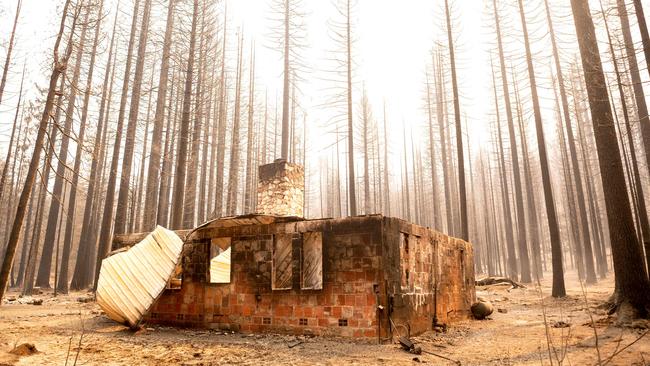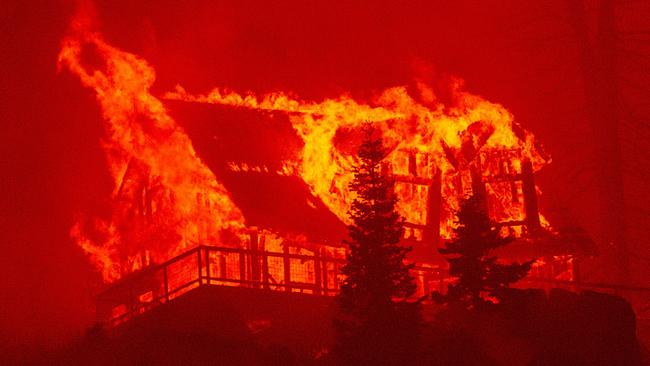Technology to the rescue of catastrophe insurance
Insurers using centuries-old data to price policies are losing billions in climate disasters. Can new AI save the industry?

Two realities are clashing in America. In one, “once-in-a-century” catastrophes now arrive monthly, such as the floods in New York brought by the remains of Hurricane Ida. Or the wildfires that nearly incinerated Lake Tahoe, California’s prized alpine idyll. Or the mega-drought in the southwest that has led to water rationing for up to 25 million people downriver from the huge Lake Mead reservoir.
However, for the average American, these extreme events barely register.
To the contrary, the nation is in the grip of a housing boom not seen since the pre-recession bubble peak of 2007 – and it is running hottest in places most likely to be walloped by catastrophes. Glenn Kelman, chief executive of Redfin, one of the biggest US real estate listing services, told CNBC recently: “Buyers just keep marching into the jaws of destruction.”
Consider Phoenix, the capital of Arizona and one of the cities that will be hit by the Lake Mead water rationing. It saw house prices surge 30 per cent in the past 12 months and is one of the fastest-growing metropolises in the nation. In June, the desert city experienced four straight days of temperatures of 46C or higher, breaking previous records.
Caught in the middle of these two realities is the insurance industry, the lubricant of America’s $US36 trillion ($49 trillion) residential real estate market. Banks will not lend against uninsured homes. The problem: the business’s actuarial models, based on centuries of data, no longer apply.
Faced with tens of billions in losses, many insurers are attempting to pull out of the areas most at risk of flooding, hurricanes and fire. In California, the insurance commissioner issued an order this month – his third in three years – forbidding them from doing so. His worry is that if the industry leaves, millions of homes will be rendered worthless, turning them into assets that no bank will finance and so no one will buy.
Into the breach have stepped start-ups that claim their machine learning-based models can break the logjam. They promise hyper-accurate and granular risk assessments that, to boot, may prove cheaper than coverage offered by traditional insurers. So the theory goes.
Stakes are high. Munich Re, the reinsurance giant, says that 2020’s record hurricane season, the west coast wildfires and flooding in China forced $US82bn ($111.5bn) in payouts – a 40 per cent increase from the previous year. In California, the 2017 and 2018 wildfire seasons wiped out a quarter of a century of the industry’s underwriting profits in the state.
Nat Manning, a founder of Kettle, a Californian reinsurance start-up that models wildfire risk, says the industry is suffering because it had outsourced its core underwriting capability during better, more predictable times – whether the third parties’ models proved any good or not. “If they provide a model and the reinsurer loses a bunch of money, they still get their bill paid,” he says. “Their incentives aren’t aligned.”

Kettle claims that it has created a better mousetrap. Its models run 696 billion risk assessments, refreshed every fortnight, that cycle through mountains of data from the grade of a hillside to the placement of a parking lot (which may act as a firebreak) to weather and satellite imagery. Such brute-force processing has only been enabled by advances in machine learning and ultra-cheap computing power.
Manning, who has raised nearly $US30m, says the result is a more accurate, house-by-house picture of risk than models that may be drawing heavily on data from centuries past. “There are over 10,000 wildfires a year in California, but last year, just 14 of them caused 99 per cent of the damage. That’s almost always the case: a few get out of hand and cause a huge amount of damage. The question is, which are going to be the 14?”
He is targeting a critical part of the market. Sitting beneath consumer insurance is the reinsurance industry, a collection of financial giants largely based in London, Bermuda and Switzerland that cover companies in case of catastrophic loss: the safety net beneath the safety net. This month, California’s insurance commissioner, Ricardo Lara, extended a ban on policy cancellations. The industry, meanwhile, is lobbying to integrate climate catastrophes into its premiums because even after steep rises in recent years, state-imposed limits mean they are still undercharging for coverage, according to Milliman, a risk-assessment firm. Reinsurers, however, are under no such restraints and have jacked up their rates, in some cases by as much as 30 times. Insurers have no choice but to pay.
Manning says: “It’s hard to have empathy for the big old insurance companies out there, but in California, they are getting really squeezed.”
Kettle, he added, can offer coverage that might be three or four times more expensive than it used to be but is still far less than the eye-watering fees charged by rival reinsurers.
Kettle is far from the only startup to alight on this oft-overlooked industry. Jupiter Intelligence, based in Palo Alto, California, offers climate change analytics and counts oil giant BP among its clients. Paris-based Descartes Underwriting, founded in 2019, offers “parametric” insurance, which pays out in the case of certain climate disasters.
The industry cleavages that climate change has opened are playing out far beyond California. Florida is battered by hurricanes that every year get more frequent and severe, while its coastline is at risk from rising sea levels.
Tulane University professor Jesse Keenan and Jacob Bradt, a Harvard researcher, found last year that Florida banks, knowing the risks of their home markets, made loans against properties and then sold them on in the secondary market with more frequency than the industry average. Buyers, including government entities, appear to have little sense of the risks they are assuming. Dubbing the practice “underwaterwriting”, they warn of institutions unknowingly scooping up billions of dollars of risky assets – similar circumstances to those that set off the 2008 recession.
Bradt says: “Normally, if a homeowner defaults, the lender gets the property as collateral, but in the context of climate risk, if the property is underwater, the value is zero.”
Jaws of destruction indeed.
The Sunday Times



To join the conversation, please log in. Don't have an account? Register
Join the conversation, you are commenting as Logout